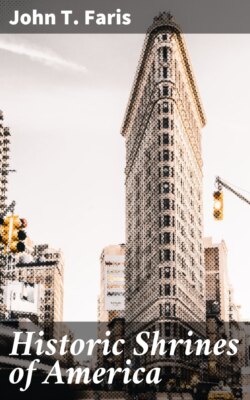Читать книгу Historic Shrines of America - John T. Faris - Страница 19
На сайте Литреса книга снята с продажи.
THE ROYALL HOUSE, MEDFORD, MASSACHUSETTS
ОглавлениеTable of Contents
FROM WHOSE ROOF MOLLY STARK SIGNALLED TO
HER HUSBAND
One who is familiar with the old plantation houses of Virginia is tempted to rub his eyes when he first sees the Royall House at Medford, Massachusetts, for this relic of Colonial days has the outbuildings, the slave-quarters, and other characteristics of so many Virginia houses. True, it has not the low wings and the stately columns at the entrance, but the doorway is so chaste and dignified that this is not felt to be a lack. Those who enter the doorway and walk reverently through the rooms of what has been called the finest specimen of colonial architecture in the vicinity of Boston, are filled anew with admiration for the builders of another day who chose the finest white pine for their work, and would not dream of scamping anywhere. Evidently there was little need in those days of the services of an inspector to see that the terms of a contract were carried out.
The history of the property goes back to 1631, when Governor John Winthrop, the first governor of the Massachusetts Bay Colony, who served for nineteen years, secured a grant to the farm on which, within six or seven years, the original dormer-windowed Royall House was built. This was smaller than the present house, but it was later incorporated in the present stately mansion; one story was added, and the outer wall was moved a few feet. Thus it is really a house within a house.
At the time of Governor Winthrop's ownership it was called the Ten-Hill Farmhouse, because ten hills could be seen from its windows. John Winthrop, Jr., sold the place to Mrs. Elizabeth Lidgett. Lieutenant Governor Usher married a Lidgett, and owned the estate until he lost it through business reverses. The name was not changed until 1732, when the house was bought by Isaac Royall, a planter from Antigua, in the Leeward Islands, a descendant of William Royall of Salem. He paid £10,350 for the estate, which then consisted of five hundred and four acres. It was he who enlarged the house. For five years the neighbors watched the transformation of the comfortable Ten-Hill Farmhouse to the great Royall House, with its enclosing wall, elm-bordered driveway, pleasing garden, summerhouse, great barn, and rambling slave-quarters.
Two generations of Royalls entertained lavishly here. Among the guests were the most celebrated men of the time, as well as many who were not so well known, for all were welcome there. Many of these guests drove up the driveway to the paved courtyard in their own grand equipages. Some were brought in the four-horse Royall chariot. But those who came on foot were welcomed as heartily.
Isaac Royall, II, was a Tory, and in 1775 he was compelled to abandon the property. Thereupon Colonel, later General, John Stark made it his headquarters. The regiment which he had himself raised, and whose wages he paid for a time from his own pocket, was encamped near by. From the Royall house these men and their intrepid leader went out to the Battle of Bunker Hill.
Under the direction of Molly Stark the house maintained its reputation for hospitality, and she did her best to make the place the abode of patriotism. On the day when the British evacuated Boston she promised her husband to signal to him from the roof the movements of the enemy. Passing on with his soldiers to Dorchester Heights, he anxiously awaited the news sent to him by his faithful Molly.
The Royall family regained possession of the property in 1805. To-day it is owned by the Royall House Association, which keeps it open to the visitors. These come in large numbers to see relics of former days, including what is said to be the only chest that survived the Boston Tea Party, the sign of the Royall Oak Tavern in Medford, which bears the marks of the bullets of the soldiers who were on their way to the Battle of Bunker Hill, the old furniture, the first fork used in the Colony, and the furnishings of the quaint kitchen fireplace, which dates from 1732.
Photo by Wallace Nutting, Inc., Framingham Center, Mass
BROADHEARTH, SAUGUS, MASS.
XIII
